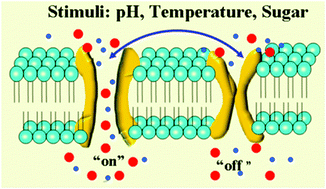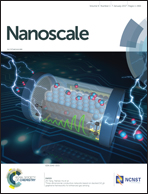A temperature, pH and sugar triple-stimuli-responsive nanofluidic diode†
Abstract
In this article, we have demonstrated for the first time a triple stimuli-responsive nanofluidic diode that can rectify ionic current under multiple external stimuli including temperature, pH, and sugar. This diode was fabricated by immobilizing poly[2-(dimethylamino)ethyl methacrylate]-co-[4-vinyl phenylboronic acid] (P(DMAEMA-co-VPBA)) onto the wall of a single glass conical nanopore channel via surface-initiator atom transfer radical polymerization (SI-ATRP). The copolymer brushes contain functional groups sensitive to pH, temperature and sugar that can induce charge and configuration change to affect the status of the pore wall. The experimental results confirmed that the P(DMAEMA-co-VPBA) brush modified nanochannel regulated the ionic current rectification successfully under three different external stimuli. This biomimetically inspired research simulates the complex biological multi-functions of ion channels and promotes the development of “smart” biomimetic nanochannel systems for actuating and sensing applications.


 Please wait while we load your content...
Please wait while we load your content...